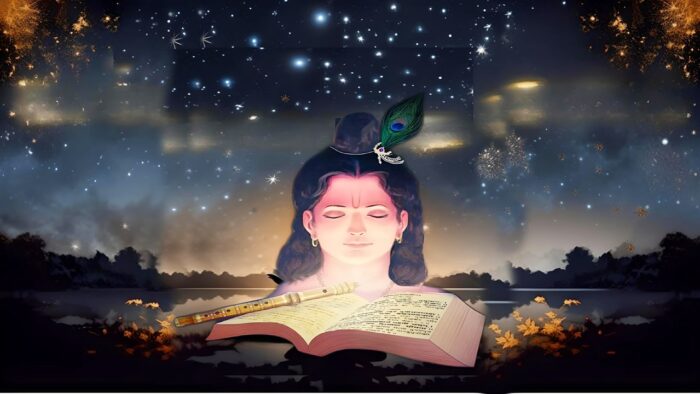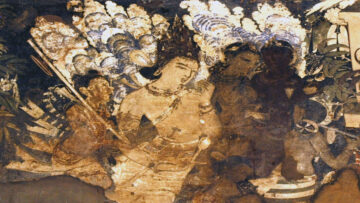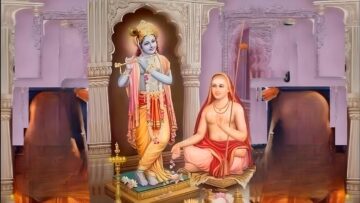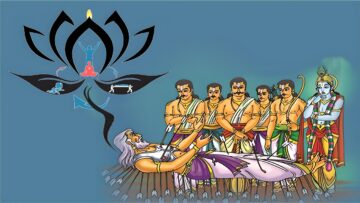The fifth chapter of the Bhagavad Gita is one of its most interesting chapters. This chapter deals primarily about the concept of karma-sannyasa or the renunciation of actions and what true sannyasa is. People generally get frightened as soon as they hear the word sannyasa. They conjure up images of yogis meditating on Himalayan peaks, mendicants moving from home to home begging for alms and food, monks living in ashrams inside forests far away from civilization. The general attitude of people towards sannyasa is astonishment and wonder if not fear itself. Krishna through his discourse in chapter#5 mostly debunks all the myths that people have towards sannyasa and make sannyasa as a concept more available to an average seeker. Krishna deals primarily with the attitude of sannyasa in this chapter rather than the ashrama-sannyasa. This is supported by the fact that both Sri Sankara and Sridhara Swami in their commentary on this chapter take digs at a mere sannayasi, i.e., the one who has only entered into the ashrama called sannyasa but does not have an attitude of sannyasa. One of the first topics dealt with in this chapter is a reconciliation of karma-yoga and karma-sannyasa and in doing so the essence of both karma-yoga and sannyasa is brought out beautifully by Krishna. Then Krishna briefly touches upon the concept of sarva-karma-sannyasa before moving the discourse towards jnana.
Karma Yoga or Karma Sannyasa
Sannyasa like many other such words in the Gita has two meanings attached to it, the literal and the conceptual. The literal meaning refers to the person who has taken a vow of sannyasa (the sannyasa-ashrama) and has hence as a result retired from worldly activities. This person in the traditional sense has renounced fire in the sense that he shall no longer conduct any of the fire rituals or cook food for himself. It basically denotes the renunciation of worldly and otherworldly concerns such as accumulation of merit etc. The sannyasi also makes a vow to never compete with any other being for any resource and to provide unconditional fearlessness to all. To be compassionate and non-violent are all intrinsic parts of becoming a sannyasi. Viraja homa is a homa that is done to produce bhasma (holy ash) that is applied on the body as a tripundra by all Smartas and Saivaites. The same homam is performed on the day of the sannyasa deeksha of a seeker. The symbolism being that just as fire turned the mango leaves or twigs into bhasma, may the fire of knowledge turn the seeker’s ignorance to ashes. This sannyasi now devotes himself exclusively to the pursuit of knowledge of the identity of Atman with Brahman. His entire life is then a single pointed devotion to the accumulation of knowledge (jnana) and then being established in this knowledge (jnana nishtha). Naturally when Krishna talks anywhere about renunciation (sannyasa) or the pursuit of knowledge (Sankhya/jnana), Arjuna naturally thinks that Krishna is encouraging him to enter into the ashrama that is sannyasa. But Krishna more often than not refers exclusively to the conceptual aspect of sannyasa.
The conceptual sannyasa is where the karma yoga attitude is maintained while performing all the activities of the day to day life. Ragas and dveshas are not given into, every activity is done with an attitude of dedication to Ishwara and all the fruits of the actions are received with prasada buddhi. Krishna calls such a person to be a nitya-sannyasi i.e., an eternal sannyasi and the one who will easily break off all bonds and gain moksha.
ज्ञेय: सनित्यसंन्यासीयोनद्वेष्टिनकाङ्क्षति |
निर्द्वन्द्वोहिमहाबाहोसुखंबन्धात्प्रमुच्यते ||B.G.5. 3||
Sridhar swami calls such a person to be regarded as a sannyasi even at the time of performing actions. Such a person gains chitta shuddhi through the performance of karma yoga and then gains knowledge which leads him to renounce all activities, sarva-karma-sannyasa which we will discuss at length later. So Krishna takes the karma yogi to also be a kind of sannyasi. The aim of karma-yoga can be understood to be two-fold. By the performance of actions dedicated to Ishwara, the seeker gains chitta-shuddhi which is a mind free of agitations and an intellect that is single pointed in its application. Such a mind-intellect is a fit instrument to pursue the path of knowledge. With the inner instrument being pacified by the practice of karma-yoga the seeker develops the attitude of sannyasa which is characterised by viveka and vairagya (discriminative faculty and becoming dispassionate). Over time such a seeker gains knowledge and ultimately becomes a sarva-karma-sannyasi.
संन्यासस्तुमहाबाहोदु:खमाप्तुमयोगत: |
योगयुक्तोमुनिर्ब्रह्मनचिरेणाधिगच्छति ||B.G.5.6||
Since sarva-karma-sannyasa or even the spirit of sannyasa characterised by a pure mind and a steady intellect cannot be reached by a seeker without the performance of karma-yoga, Krishna declares karma-yoga to be greater than karma-sannyasa.
Sarva Karma Sannyasa
Krishna then talks about sarva-karma-sannyasa in the following verse.
सर्वकर्माणिमनसासंन्यस्यास्तेसुखंवशी |
नवद्वारेपुरेदेहीनैवकुर्वन्नकारयन् ||B.G.5.13||
Also the most famous shloka of chapter 18th also talks about total renunciation.
सर्वधर्मान्परित्यज्यमामेकंशरणंव्रज |
अहंत्वांसर्वपापेभ्योमोक्षयिष्यामिमाशुच: ||B.G.18.66||
This is a greatly misunderstood concept both within and outside Advaita Vedanta. Sankara refers multiple times in his commentary to sarva-karma-sannyasa and considers it a necessary mark for liberation. The general argument put forth by other schools of thought against Sankara and Advaita in general on this point of sarva–karma-sannyasa is this “Arjuna was contemplating sannyasa in the first chapter of the Gita and Krishna showed him the path of action and hence prevented him from taking a hasty dash into sannyasa. So sarva-karma-sannyasa is not a concept preached by Krishna and nowhere does Gita support sarva-karma-sannyasa.” The answer to this argument is- It’s true that Krishna brought Arjuna to the path of action while Arjuna was contemplating about taking sannyasa. It would be unwise to suggest otherwise. Also Krishna stated very categorically that none can remain even for a second without doing any action. Hence by the very nature of statements put forth by Krishna it is well established that “the sarva-karma-sannyasa” that Krishna talks about is different from its literal meaning. Or else Krishna would be contradicting himself. It is established that in Krishna’s philosophy, the self is a non-doer and all actions are performed only by the body-mind complex.
प्रकृते: क्रियमाणानिगुणै: कर्माणिसर्वश: |
अहङ्कारविमूढात्माकर्ताहमितिमन्यते || B.G.3.27||
प्रकृत्यैवचकर्माणिक्रियमाणानिसर्वश: |
य: पश्यतितथात्मानमकर्तारंसपश्यति ||B.G.13.30||
नान्यंगुणेभ्य: कर्तारंयदाद्रष्टानुपश्यति |
गुणेभ्यश्चपरंवेत्तिमद्भावंसोऽधिगच्छति || B.G.14.19||
निराशीर्यतचित्तात्मात्यक्तसर्वपरिग्रह: |
शारीरंकेवलंकर्मकुर्वन्नाप्नोतिकिल्बिषम् ||B.G.4.21||
Also it is well established that a man of realisation has no sense of agency in him as his identification of the Self as Pure Consciousness is perfect. It is not that a jnani does not act, but while others see the body acting and confuse it with the Self, the jnani is perfect in his knowledge that only the body-mind complex acts and Self ever remains a non-doer.
नैवकिञ्चित्करोमीतियुक्तोमन्येततत्त्ववित् |
पश्यञ्शृण्वन्स्पृशञ्जिघ्रन्नश्नन्गच्छन्स्वपञ्श्वसन् ||B.G.5.8||
प्रलपन्विसृजन्गृह्ण्न्नुन्मिषन्निमिषन्नपि |
इन्द्रियाणीन्द्रियार्थेषुवर्तन्तइतिधारयन् ||B.G.5.9||
It’s not even that the Self was a doer prior to jnana and after jnana the doership has vanished. The Self was always a non-doer, irrespective of the conditions of ignorance or knowledge.
नकर्तृत्वंनकर्माणिलोकस्यसृजतिप्रभु: |
नकर्मफलसंयोगंस्वभावस्तुप्रवर्तते ||B.G.5.14||
Ignorance and knowledge being states of the intellect, the seeming realisation of the falsity of the notion of doership after knowledge is termed as sarva-karma-sannyasa. The renunciation of the concept of agency that is acquired by firmly establishing himself in jnana is called sarva–karma-sannyasa.
योगसंन्यस्तकर्माणंज्ञानसञ्छिन्नसंशयम् |
आत्मवन्तंनकर्माणिनिबध्नन्तिधनञ्जय || 41||
If we take the literal meaning of the word sarva-karma-sannyasa, then it would mean that all actions will have to be renounced. Apart from that being a ridiculous proposition, the one who will be renouncing i.e. the renouncer shall remain even after the said renunciation, the sense of agency shall remain and it will be an indication that jnana has not been gained. Hence sarva-karma-sannyasa is only a mental renunciation of the concept of agency while being firmly established in the Knowledge of Brahman.
Conclusion
Krishna discourses on a twofold definition of sannyasa. While one deals with the attitude of the karma-yogi during action, the other is a realisation as a result of being firmly established in jnana. Though sannyasa-ashrama is a great institution for the people who have the necessary preparation, most of the seekers will not be benefitted by it owing to a lack of proper preparation i.e. chitta shuddhi reached by karma-yoga. But all is not lost because Krishna’s discourse is not aimed at the fully prepared seeker like those of the Upanishads. Krishna’s focus of attention is the majority who have a long way to go. May we all cultivate true sannyasa within our hearts.
References
- The Holy Geeta- Swami Chinmayananda
- Bhagavad Gita Vol.4 -Swami Dayananda Saraswati
- Geeta Darshan Vol.2 – Swami Akhandananda Saraswati
- Bhagavad Gita with the commentary of Sankaracharya- Swami Gambhirananda
- Srimad Bhagavad Gita, Sridhara Swami gloss- Swami Vireshwarananda
- Bhagavad Gita with Shankara’s Bhashya- Geeta Press
Disclaimer: The opinions expressed in this article belong to the author. Indic Today is neither responsible nor liable for the accuracy, completeness, suitability, or validity of any information in the article.










